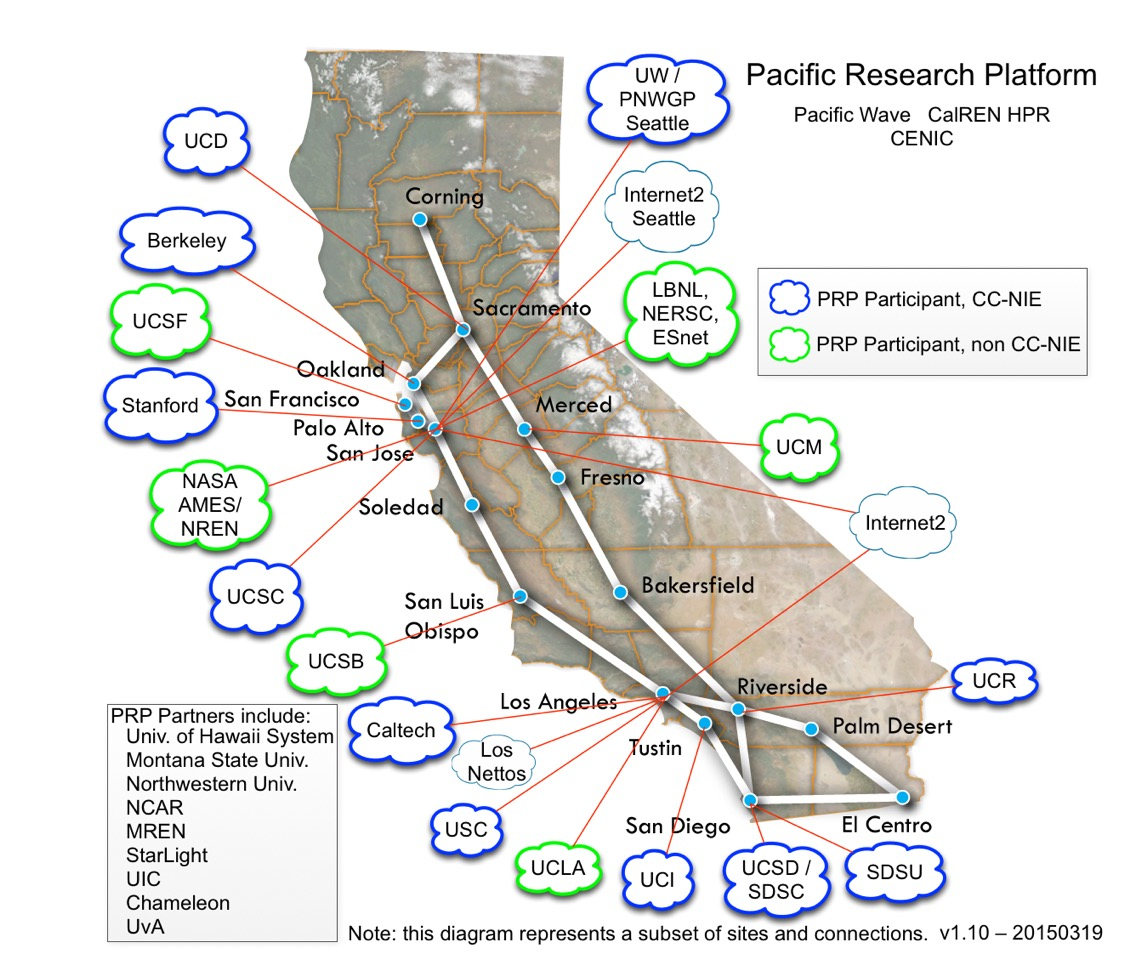A Novel Advanced International Communications Facility
By Joe Mambretti
Chicago, March 26, 2015 — A five-year grant to develop an international Software Defined Networking Exchange (SDX) at the StarLight International/National Communications Exchange Facility was announced this week at the Global Lambda Integrated Facility (GLIF) Technical Working Group biannual meeting in Washington, D.C. Researchers at the UC San Diego Qualcomm Institute will receive $720,000 as part of the grant.

The GLIF meeting was co-located with the Open Grid Forum, the Global Environment for Network Innovations (GENI) Engineering Conference (GEC 22), and the US Ignite Applications Summit – “Beyond Today’s Internet: Experiencing a Smart Future.” A consortium of universities received funding to design, develop, and operate the StarLight SDX from the National Science Foundation (NSF) International Research Network Connections (IRNC) program.
The StarLight SDX, located in Chicago, is part of an international effort to interconnect research and education networks that support Software Defined Networking (SDN), an innovative architecture that enables application communities, scientists, and engineers to directly program their networks to meet their precise requirements. SDN enables direct control over the network paths and attributes, which is an especially important capability for supporting extremely large scientific data flows. SDNs are proliferating, however, almost all are single domain oriented; SDXs will ensure that multiple SDN domains can interoperate. SDXs also provide enhanced visibility into individual data streams at exchanges and control over those streams. SDXs can also be customized to support the specific workflows of domain science research.
It's anticipated that the SDX will enable computational analysis of data from the Large Hadron Collider and so-called "'omics" research — genomics, proteomics, etc. — and will eventually create special interest research groups.
The StarLight SDX, together with other SDXs worldwide, will support continued research, development, experimental deployment, and trials of multi-domain SDXs, and it will serve as an innovation platform on which to introduce next-generation services, architectures, policies, processes, and technologies. More specifically, the StarLight SDX will focus on three main activities: (1) development of the StarAX (StarLight Advanced eXchange) Innovation Engine, an SDN Development Environment that will enable facilities around the world to provide multiple network functions and features quickly and reliably, and to deploy SDXs that are compatible and interoperable with others, (2) deployment of an instance of this system at the StarLight Facility, and (3) providing coordination and assistance to others around the world to deploy such systems at their exchange points. This innovative exchange facility will be able to support a wide range of new international services and capabilities for global research and education.
Led by the International Center for Advanced Internet Research (iCAIR) at Northwestern University, the consortium includes the Electronic Visualization Laboratory (EVL) at the University of Illinois at Chicago and the Qualcomm Institute division of Calit2 (Calit2-QI) at UC San Diego. The consortium also includes many international SDX partners, all of whom are founding members of the GLIF, which organized this week’s GLIF Technical Workshop. GLIF participants are National Research and Education Networks (NRENs), consortia and institutions involved in advanced optical networking and research, and are engaged in creating and exploring prototypes of multiple, innovative communication services and technologies.
The StarLight SDX initiative also builds on the efforts of early GENI projects, including a GENI SDX exchange and the International GENI (iGENI) initiative, which developed a unique distributed SDN/OpenFlow global infrastructure that supports research and development for next-generation network communication services and technologies.
About the International Center for Advanced Internet Research (iCAIR) at Northwestern University
The International Center for Advanced Internet Research (iCAIR) at Northwestern University accelerates leading-edge innovation and enhanced global communications through advanced technologies, in partnership with numerous international community, and national partners. iCAIR partners with EVL at University of Illinois at Chicago and Argonne National Laboratory, in collaboration with Canada's CANARIE and the Netherlands' SURFnet, to manage and grow the StarLight optical network exchange. (www.icair.org)
About the Electronic Visualization Laboratory at the University of Illinois at Chicago
The Electronic Visualization Laboratory (EVL) at the University of Illinois at Chicago is an internationally renowned interdisciplinary research laboratory whose mission is to enable scientific and engineering discoveries by designing and developing high-performance visualization, virtual reality, and collaboration systems using global cyberinfrastructure. Established in 1973 as a joint effort of the UIC College of Engineering and School of Art and Design, EVL is the oldest formal collaboration between engineering and art in the U.S. EVL partners with iCAIR at Northwestern University and Argonne National Laboratory, in collaboration with Canada's CANARIE and the Netherlands' SURFnet, to manage and grow the StarLight optical network exchange. (www.evl.uic.edu)
About the StarLight International/National Communications Exchange Facility
With more than 30 100 Gbps connections, the StarLight International/National Communications Exchange Facility is the world's most advanced and highest capacity optically based networking exchange facility. StarLight provides advanced networking services and technologies that are optimized for high-performance, large-scale metro, regional, national and global applications. With funding from the National Science Foundation (NSF), StarLight was designed and developed by researchers, for researchers. StarLight is managed by the International Center for Advanced Internet Research (iCAIR) at Northwestern University, the Electronic Visualization Laboratory (EVL) at the University of Illinois at Chicago, and the Mathematics and Computer Science Division at Argonne National Laboratory, in partnership with Canada's CANARIE national networking organization and The Netherlands' SURFnet. (www.startap.net/starlight)
About the Global Lambda Integrated Facility (GLIF)
The Global Lambda Integrated Facility (GLIF) is an international virtual organization that promotes the paradigm of lambda networking (primarily using lightpaths on optical fiber). GLIF participants are National Research and Education Networks (NRENs), consortia and institutions working with lambdas. Participation in GLIF is open to any organization that subscribes to the GLIF vision and can contribute to the GLIF activities. (www.glif.is)
Media Contacts
Joe Mambretti, International Center for Advanced Internet Research (iCAIR), Northwestern University
j-mambretti@northwestern.edu
Maxine D. Brown, Electronic Visualization Laboratory, University of Illinois at Chicago, maxine@uic.edu
Tiffany Fox, Qualcomm Institute, University of California, San Diego, (858) 246-0353, tfox@ucsd.edu
Related Links
StarLight International/National Communications Exchange Facility

